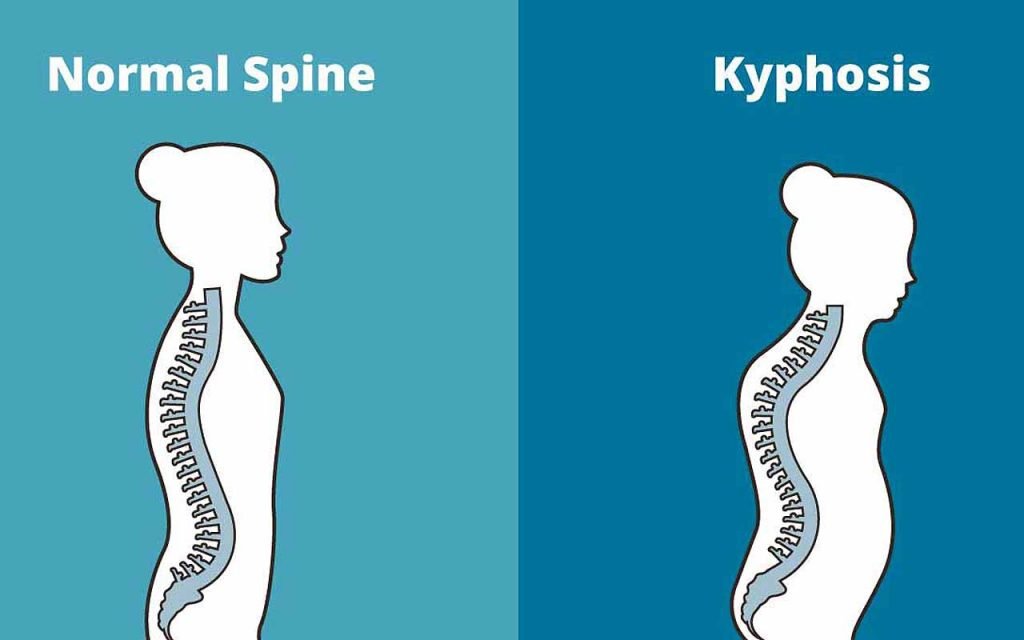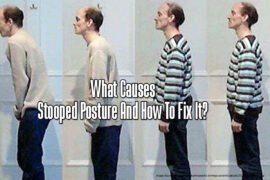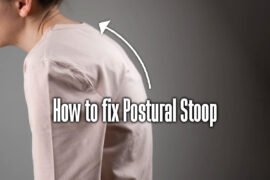It is this curve that determines your posture as you walk, sit or stand. An exaggerated kyphotic curve (curved more than 40 to 45 degrees) is a sign that you may have thoracic kyphosis.

Types of Thoracic Kyphosis Symptoms
Table of Contents
There are several types of adult kyphosis but we will just look at five:
Post-traumatic Kyphosis
When your spine is injured there is a huge risk that you will develop kyphosis or experience nerve problems in the spine. Injuries likely to lead to kyphosis include those that cause a vertebral fracture in the thoracic spine. You run the risk of fracturing your vertebrae in accidents involving horse riding, motor vehicles, falling from a great height and so on.
Doctors may ask you if you were involved in an accident before you developed the condition as one of the ways to diagnose thoracic kyphosis of this type.
Congenital Kyphosis
Sadly, when a genetic mistake occurs in your body before you are born, it can result in the failure of formation or segmentation of the front part of one or more vertebral bodies and discs. This defect leads to the abnormal development of the spine as you grow, and it may continue affecting you in adulthood. Kyphosis developed as a result of a genetic mistake is what is called congenital kyphosis.
Post-surgery Kyphosis
After surgery done to correct problems on your spine, there is a chance that you may develop kyphosis. This mainly happens when the area that underwent surgery did not heal properly. The most likely solution is for you to undergo a second operation to correct the problem.
Postural Kyphosis
Sometimes called “round back”, postural kyphosis is caused by poor posture and normally affects young adults and adolescents. It is the most common type of kyphosis and can easily be corrected by literally standing up straight. It is not caused by any structural problems or abnormality of the spine and it is unlikely to progress.
Doctors may use many ways to diagnose thoracic kyphosis of this type, but they are more likely to look at your sitting posture or standing posture. You may have seen cartoons develop this kind of kyphosis when they are sad or lack confidence.
Scheuermann’s Kyphosis
It is considered as the most common type of structural kyphosis and people who have it have a thoracic curve of 40 to 75 degrees. In this case, your kyphotic curve becomes abnormal because of the wedging of three or more vertebrae in a row.
Unfortunately, experts still do not know the exact cause of this type of kyphosis but some believe that it could be a result of abnormal bone growth and development. It is normally diagnosed between the ages of 12 and 14.
kyphosisTypesWant to use this infographic on your site?
Other Causes
You may develop kyphosis from any condition that can decrease the height of the front part of the spine. For example, older adults, especially females, can develop kyphosis caused by osteoporosis because the condition can lead to crushed vertebrae. Other ailments like infections in the spine, cancer in the spine and some types of arthritis can also cause kyphosis.
Symptoms of Kyphosis
Now that you know the types of kyphosis it is important that you know that the symptoms depend on the severity of the condition. The symptoms include:
- You may experience pain in the area of the kyphosis, which could become severe and disabling if nothing is done to treat it.
- Severe cases of kyphosis have also been known to reduce appetite because the curve may cause the abdomen to be compressed.
- Your lower extremities could also experience weakness when the curve is severe and puts pressure on the spinal cord leading to compression of the nerves in the spinal cord.
- A thoracic spine curve could also make it difficult to breathe and may also affect the function of your heart.
Diagnosis
When you spot these symptoms, it is important that you see a doctor for a diagnosis so that an appropriate treatment plan can be developed for you. The doctor will perform a physical examination and then measure your spine’s overall curvature during an x-ray evaluation.
He or she may also ask for your medical history so as to rule out any other possible causes of your kyphosis. Once the x-ray evaluation confirms the kyphosis the doctor may order other tests. For instance, the doctor may order an MRI scan to asses if there is any encroachment on the nerves or to predict the progression of the spinal deformity.
You may also undergo a CT scan especially if the orthopedist suspects you have an injury that does appear on your X-ray.
Treatment
Fortunately, surgery is always the treatment of last resort for adult kyphosis because of the many risks involved. Your treatment will be determined based on your age, the extent of the curve, symptoms and the underlying cause of kyphosis. The Two types of treatments include:
Nonsurgical Treatment
Thoracic kyphosis refers to an excessive upper back curvature, leading to a rounded or hunched posture. Nonsurgical treatment options for thoracic kyphosis include:
Physical Therapy
Physical therapy can help stretch and strengthen the back, neck, and shoulder muscles to improve posture and reduce pain. The physical therapist may also use manual therapy techniques, like massage and joint mobilization, to relieve tension and improve the range of motion.
Wearing Braces
Back braces are normally recommended for curves that progress and are meant to straighten the spine to prevent further progression. They are not meant for kyphosis treatment in adults but for patients who are still growing (like adolescents). You can use a posture corrector or a posture corrector shirt.

Exercise
Specific exercises can help improve posture and strengthen the back, neck, and shoulder muscles. These exercises may include yoga, Pilates, or other forms of exercise that focus on building core strength.
Pain Management
Over-the-counter pain medications, such as ibuprofen or acetaminophen, can help relieve pain associated with thoracic kyphosis. Sometimes, a doctor may prescribe stronger pain medication or recommend injections to reduce inflammation.
Lifestyle Modifications
Certain lifestyle modifications, like maintaining a healthy weight, avoiding high-impact activities that can worsen the condition, and practicing good posture, can help prevent the progression of thoracic kyphosis.
Surgical Treatment
Thoracic kyphosis refers to an excessive curvature of the thoracic spine, which can lead to a hunchback or round-back appearance. The surgical treatment of thoracic kyphosis typically involves correcting the abnormal curvature of the spine through a procedure known as spinal fusion.
Spinal fusion is the surgical technique that involves fusing two or more vertebrae together to strengthen the spine and correct its alignment. This procedure is generally performed under general anesthesia and may take several hours to complete.
During this procedure, the surgeon will make an incision in the back and expose the affected area of the spine. The surgeon will remove damaged or diseased tissue and use screws, rods, and bone grafts to fuse the affected vertebrae together. The goal is to create a solid, stable structure that will support the spine and correct its alignment.
After the surgery, the patient will need to stay in the hospital for some days to monitor their recovery. They may also need to wear a brace or cast for several weeks or months to help support the spine as it heals. Physical therapy may also be necessary to help restore strength and flexibility to the spine.
As with any surgical procedure, there are many risks associated with spinal fusion surgery, including infection, bleeding, nerve damage, and failure of the bones to fuse properly. However, for many patients with severe thoracic kyphosis, spinal fusion surgery can effectively improve their quality of life and reduce pain and discomfort.
Exercises For Thoracic Kyphosis
Wall Angels
Stand with your back against your wall, your feet shoulder-width apart, & arms at your sides. Slowly raise your arms overhead, keeping your elbows and wrists in contact with the wall. Then very slowly, lower your arms back down to your sides. Repeat for 10-15 reps.
Foam Roller Stretch
Lie your back with a foam roller placed under your upper back. Bend your knees and place your feet will flat on the floor. Place your hands behind the head and gently roll up and down along your upper back. This will help to mobilize the thoracic spine and relieve tightness.
Scapular Squeeze
Sit or stand with your arms at your sides. Squeeze your shoulder blades together and hold them for a few seconds before releasing them. Repeat for 10-15 reps.
Thoracic Extension
Sit on the floor with your crossed legs and your hands placed behind your head. Slowly arch your upper back backward as far as you can comfortably go. Hold for a few seconds before returning to the starting position. Repeat for 10-15 reps.
Cat-Cow Stretch
Lower your hands on all fours, keeping your shoulders under your shoulders and your knees directly under your hips. Inhale and arch your back, then lift your head and tailbone towards the ceiling. Exhale and round your spine, then tuck your chin into your chest and bring your tailbone toward your knees. Repeat for 10-15 reps.
Chest Stretch
Stand facing a doorway with your arms at your sides. Place your forearms against the doorway and lean forward, stretching your chest. Hold for 30 seconds and repeat 2-3 times.
Things To Take Care of While Suffering From Thoracic Kyphosis
Thoracic kyphosis is a medical condition in which the thoracic spine (the upper and middle part of the back) is excessively curved forward, causing a hunched or rounded posture. Here are some things to take care of while suffering from thoracic kyphosis:
- Maintain proper posture: One of the most important things you can do to manage thoracic kyphosis is to maintain proper posture. This means sitting and standing up straight, with your back shoulders and your head in a neutral position.
- Do stretching exercises: Regular stretching exercises can help improve the flexibility of your spine and prevent further curvature. Exercises such as chest stretches, upper back stretches, and neck stretches can be particularly helpful.
- Strengthen your core: If you Strengthen your core muscles, it can help support your spine and improve your posture. Exercises such as planks, bridges, and crunches can help strengthen your core.
- Avoid long periods of sitting: Prolonged sitting can cause your spine to curve forward and exacerbate your thoracic kyphosis. Try to take regular breaks and walk around every hour or so if you have to sit for long periods.
- Use proper ergonomics: Make sure your work or study environment is set up properly with ergonomic chairs, desks, and computer monitors that are at the right height. This will help you maintain good posture and prevent further curvature.
- Consult with a healthcare professional: If you are experiencing pain or discomfort related to thoracic kyphosis, it’s essential to consult with your healthcare professional. They can provide you with additional recommendations and treatment options that are tailored to your specific needs.
FAQs
1. What causes thoracic kyphosis?
There are several possible causes of thoracic kyphosis, including congenital deformities, degenerative diseases such as osteoporosis, and injuries to the spine. Kyphosis can be caused by poor posture or certain muscle imbalances.
2. How is thoracic kyphosis diagnosed?
Thoracic kyphosis is typically diagnosed through a physical examination, during which the doctor will assess the patient’s posture and range of motion. X-rays, CT scans, and MRI scans may also be used to visualize the spine and determine the severity of the curvature.
3. How is thoracic kyphosis treated?
The treatment of thoracic kyphosis depends on the severity of the curvature and the underlying cause. Non-surgical treatments may include physical therapy, bracing, and exercises to improve posture and strengthen the back muscles. In severe cases, surgery can be necessary to correct the curvature and stabilize the spine.
4. Can thoracic kyphosis be prevented?
While it is not always possible to prevent thoracic kyphosis, maintaining good posture and engaging in regular exercise can help to decrease the risk of developing this condition. It is also important to get enough calcium and vitamin D to maintain strong, healthy bones.
5. Is thoracic kyphosis a serious condition?
In most cases, thoracic kyphosis is a manageable condition that can be treated successfully. However, severe cases of thoracic kyphosis can lead to serious complications, such as difficulty breathing and deformity, and may require surgery to correct.
Conclusion
Thoracic kyphosis not only causes you pain but it can also affect your self-esteem. Early diagnosis and treatment of this condition can help you make tremendous progress. Remember:
- Do not self-diagnose but instead see an orthopedist if you suspect you have the condition
- If you are diagnosed with the condition, stick strictly to the treatment program designed for you
- Avoid homeopathic treatments or ask your doctor first before you try such treatments
Please leave a comment or a question about ways to diagnose thoracic kyphosis and treatment and we will get back to you as soon as possible.








1 Comment
This is an excellent article. I am very pleased to read your article, It gives me some great Information that I’m looking for. Thanks and keep sharing 🙂